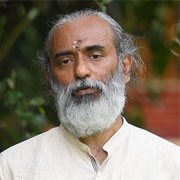Witnessing life of Lord Krishna through Guruvayur’s Krishnanattam Kali

Mail This Article
Nestled amidst rich cultural heritage and fervent religious devotion, Guruvayur Temple stands as a revered sanctuary frequented by countless devotees from all corners of the country. Each day, they throng the temple, seeking the blessings of Lord Krishna and immersing themselves in the quintessence of spirituality.

According to ancient scriptures, this temple, often referred to as 'Bhooloka Vaikunta' (Heaven on Earth), is the divine abode of Lord Sree Krishna. Legend has it that Lord Vishnu himself had once worshipped this idol, which later became the object of devotion for Lord Krishna prior to his ascension to heaven.

Guruvayur Temple is renowned not only for its profound spirituality but also for its distinctive rituals and offerings that resonate with the faithful. Devotees offer a variety of rituals such as Thulabhaaram, Abhishekam, Niramaala, Neyvilakku, Thripuththari, Udayasthamaya Pooja, and others to honor Lord Krishna. Among these offerings, 'Krishnanattam Kali' holds a special place. This unique ritual also serves as a significant temple art form in Kerala and is exclusively taught and practised at Guruvayur Temple.

Legend
Prince Manavedan, a Zamorin Raja of Calicut, composed ‘Krishnanattam’ in the 17th century. According to the scriptures, the prince, also a devotee of Lord Krishna, expressed his desire to see the deity once to Vilwamangalam Swamiyar, a saint who was believed to have the ability to see God. The deity appeared before the prince in the form of a child and gave him a peacock feather. Inspired by this incident, Manavedan wrote the story of Lord Krishna in eight dramas: Avathaaram, Kaaliyamardanam, Raasakreeda, Kamsavadham, Swayamvaram, Baanayuddham, Vividavadham, and Swargaarohanam.

“These eight parts were transformed into dance dramas, which were performed for the Zamorin royal family initially and then in temples across the state. However, the royal family handed over the right to conduct the performances to Guruvayur Devaswom in 1958,” said Sukumaran, a retired Krishnanattam Kali artist.

Significance of the offering
According to legends, each story of ‘Krishnanattam Kali’ serves a purpose: Avatharam (for the birth of a child), Kaliyamardanam (to counteract the effects of poison), Rasakreeda (for single women and a happy marital life), Kamsavadham (to overcome enmity), Swayamvaram (to hasten matrimony), Banayuddham (to fulfil any wishes or conducted on auspicious days such as birthdays), Vividavadham (to eradicate poverty and for better yield for farmers), and Swargarohanam (to have a peaceful death or for salvation or a departed soul’s peace).

“There are days when 800-1000 people book for a certain performance on a single day. It is all about their beliefs, and many have positively impacted their lives,” said Sukumaran. He added that several people do this yearly offering as a sign of dedication to Lord Krishna.
The performances are held from September to May, except on certain special days in the temple.

The art and performers
Many times, ‘Krishnanattam Kali’ is confused with ‘Kathakali’, another well-known form of art from Kerala. While there may be some visual parallels between the costumes and makeup, there are no other commonalities between them. ‘Krishnanattam Kali’ artists and aspirants receive training from Guruvayur Devaswom’s Kshetrakalaanilayam, located near the temple.

Another retired ‘Krishnanattam Kali’ artist, Sethumadhavan, explained the importance of devotion and hard work in mastering this art form. “Artists join the institution at a very young age and have to undergo rigorous training from 3 am almost every day. The course duration is 10 years,” he said. Sethumadhavan, who started learning this art at the age of 8, added that the artists will begin getting ready for an act at 6 pm to perform at 11 pm.

A play may require nine to fourteen artists, and performers have the opportunity to play every character in these acts at least once in their lifetime. Kaliyogam Aashaan is an experienced artist who is in charge of deciding which characters to assign to actors. “It takes years of physical training, dedication towards ‘Krishnanattam Kali', and a good understanding of its purpose to perform well,” he said.
Sukumaran mentioned that aspirants must also possess a keen eye for the art form and a sense of rhythm. “Many applicants are turned down or quit because they can't keep up with the pace and don't give it their all during the training," he stated.

Experiencing divinity
“We as artists put in all efforts to improve our performance every time. The devotion that we see in audiences’ eyes brings us closer to this spiritual art form,” said Renjith Raj M R, a young ‘Krishnanattam Kali’ artist.
The art form is also performed by artists from Guruvayur in various other temples in the state. “We used to also get invitations from other countries asking us to perform there,” said Sukumaran. The retired artist recalled a French woman named Sarah Blosho who admired ‘Krishnanattam Kali’ and travelled to Thrissur to understand this art.

“She had written a book based on this art form in French with the help of a scholarship offered by the French government. She used to spend most of her time around the temple, knowing more about the art and having conversations with artists,” he said. He added that she was in talks with Guruvayur Devaswom to organise performances in France; however, she passed away later while undergoing treatment for a liver ailment.
We feel privileged to serve as a conduit for the followers of Lord Guruvayurappan. Whenever we perform, we silently pray to God to bless them and continue spreading hope and goodness," Sethumadhavan stated.
"They perceive different deities in us, and isn't it an honour to perform in front of so many people, with even Lord Guruvayurappan among them enjoying our act to the fullest?" he continued.


